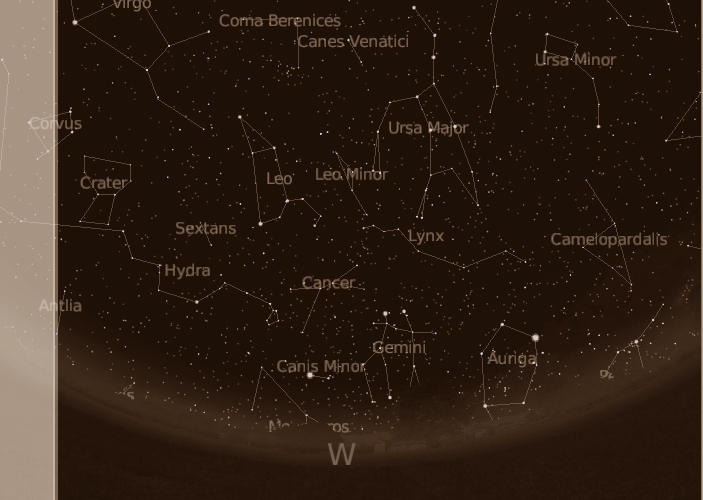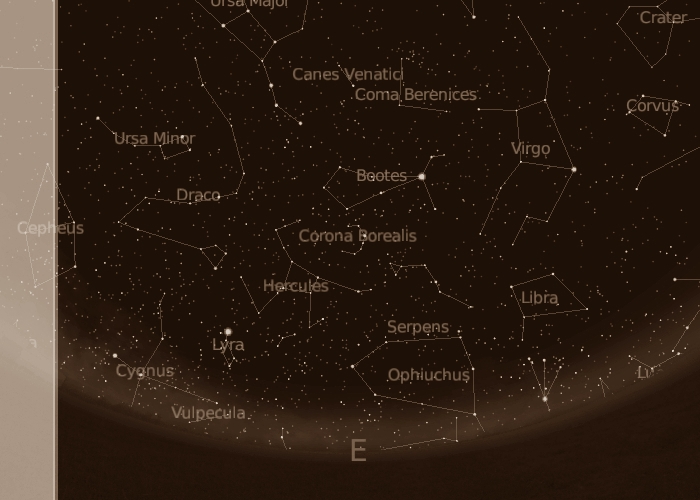Western Horizon
Eastern Horizon
![]()
Western Horizon
Eastern Horizon

We're in spring! A fine sight is provided West as the upper part of the great winter sky is gleaming of its last gleams from the West to the northwest, over the horizon, with Procyon, Gemini, the Twins and Capella, of Auriga, the Charioteer. The row above is less of bright. It's not devoided of interest however. Camelopardalis, the Girafe and Lynx, the Lynx are seen northwest, as, West, Cancer, the Crab -with the famed M44, an open cluster, Praesepe- is worth the observation. Left of Cancer, the head of Hydra is a fine view. The bright star above is Regulus, of Leo, the Lion. Parts of Ursa Major, the Great Bear are tending to descent from the zenith. You can complement these views on the western horizon. Should you turn South, a fine, large vista is provided, as the long chain of Hydra, the Hydra is stretching at length, as Sextans, the Sextant, Crater, the Cup, and Corvus, the Crow are anchored along! The bright star left is Spica of Virgo, the Virgin, as the bright star to the upper right is Regulus. Fine! It's a good time, at last, for the deep-sky galaxy fields of Virgo and Coma Berenices, as they are high now. to a printer-friendly chart
West for the tropics. West for the mid-southern latitudes

As, southeast and high, we'll find back Spica of Virgo, the Virgin, as the other bright star, more East, is Arcturus. That's a good occasion, albeit high now, the check the famed astronomical saying: 'Arc to Arcturus, speed on to Spica.' This is meaning that there is a good mnemotechnical way to find both those bright stars, as Arcturus is to be found with you extending the arc of the three stars of the Big Dipper's handle, as the extension extended again brings you to Spica. Just check that! Fine! Lower, East and southeast, you'll find one of the Serpents of Ophiuchus, as Ophiuchus, the Serpent Holder itself, is rising. Libra, the Scales, are seen too, as those with a free horizon, will be able to spot the first stars of Scorpio, the Scorpion. Slightly northeast, Hercules, the Heroe, is now high, and a fine target. Hercules is a quadrilateral of stars, with extensions. M13, the famed globular cluster, is part of the show, and a fine binocular object. M13, now, is to be found at one-third the length of the upper side of the quadrilateral, starting at the left star. As Draco, the Dragon, is now high northeast, a show of interest is seen lower, as the summer sky begins to rise! The bright star easily visible there is Vega, of Lyra, the Lyra. Stars to its lower left, are Deneb, and stars of Cygnus, the Swan. You'll maybe need a plain horizon to really catch them. North, at last, Cassiopeia, the Queen, now W-shaped, is well proving its circumpolar nature as it's grazing the horizon. Cepheus, Cepheus is to its upper right. Circumpolar constellations, in the northern or the southern hemisphere, are constellations which can be seen all year long as, due to their declination, they do never dip under the horizon. Fine! to a printer-friendly chart
East for the tropics. East for the mid-southern latitudes
(color maps with Stellarium; printer-friendly charts with Cartes du Ciel, Patrick Chevalley)
Website Manager: G. Guichard, site 'Amateur Astronomy,' http://stars5.6te.net. Page Editor: G. Guichard. last edited: 12/28/2010. contact us at ggwebsites@outlook.com